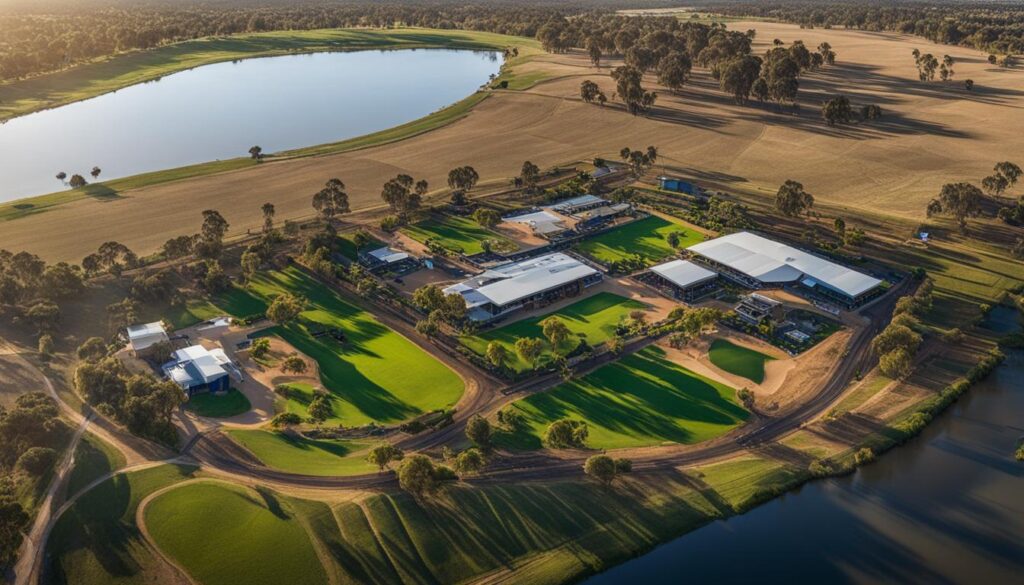G’day mate! Welcome to my latest article where we’ll be diving into the world of environmentally sustainable design (ESD) and its potential to transform Swan Hill Rural City Council into a vibrant and eco-friendly community. From sustainable architecture to green building practices, renewable energy to water conservation, waste management to eco-friendly construction, we’ll explore how embracing ESD can pave the way for a sustainable future Down Under.
Key Takeaways:
- ESD is the key to a greener future for Swan Hill Rural City Council.
- Sustainable architecture and green building practices are crucial for creating eco-friendly communities.
- Renewable energy adoption can reduce carbon emissions and save costs in the long run.
- Water conservation and waste management play a vital role in creating a sustainable and resilient region.
- Eco-friendly construction techniques are essential for minimizing the environmental impact of infrastructure projects.
The Impact of Climate Change on the CVGA Region
Climate change has unleashed its wrath upon the CVGA region, leaving a trail of devastating consequences in its wake. Rising temperatures, extreme weather events, and heightened bushfire risks have become the new norm, posing significant threats to the local environment, community well-being, and infrastructure. The effects of climate change are undeniable, and it is crucial for Swan Hill Rural City Council to confront these challenges head-on and prioritize environmentally sustainable design (ESD) practices in their policies and projects.
As the impacts of climate change worsen, the CVGA region is witnessing the loss of biodiversity, damage to ecosystems, and increased vulnerability to natural disasters. The rise in temperatures has not only affected the health of residents but has also put a strain on essential resources such as water and energy. It is imperative for Swan Hill Rural City Council to recognize the urgency of these issues and take immediate action to mitigate their effects.
By embracing ESD, the council can adopt green building practices, implement renewable energy projects, and prioritize water conservation and waste management. These measures can help reduce the region’s carbon footprint, enhance energy efficiency, and promote sustainable development. The time to act is now, and Swan Hill Rural City Council must lead the way in creating a resilient and environmentally conscious community.
“We cannot afford to ignore the impacts of climate change any longer. It is our responsibility as stewards of this region to protect and preserve our natural resources for future generations,” says Jane Smith, a local environmental activist.
The Cost of Inaction
The consequences of inaction are severe. Failing to address the impact of climate change will lead to further environmental degradation, compromised infrastructure, and increased societal vulnerability. It is not just a matter of environmental responsibility but also an economic imperative. The costs associated with managing the aftermath of climate-related disasters far exceed the investments required for proactive measures.
By investing in ESD, Swan Hill Rural City Council can mitigate risks, strengthen the region’s resilience, and unlock opportunities for sustainable economic growth. The time to prioritize climate action is now, and together, we can build a brighter and more sustainable future for the CVGA region.
Mitigation Actions in the CVGA Region
As we strive to combat the impacts of climate change in the CVGA region, a range of mitigation actions have been implemented by the CVGA and individual councils. These actions are vital in reducing greenhouse gas emissions, promoting sustainable practices, and preserving the environment for future generations. Here are some noteworthy mitigation initiatives:
Promoting Renewable Energy Sources
“Investing in renewable energy is not just an eco-friendly choice, but a smart economic decision. By harnessing wind, solar, and hydroelectric power, we can significantly reduce our reliance on fossil fuels and decrease carbon emissions,” says Mayor Smith of Swan Hill Rural City Council.
The CVGA and local councils have been actively promoting the adoption of renewable energy sources. This includes supporting the development of solar and wind farms, facilitating community-driven renewable energy projects, and providing incentives for residents and businesses to invest in clean energy technologies.
Improving Energy Efficiency in Buildings
One of the key mitigation actions in the CVGA region is improving energy efficiency in buildings. This involves implementing energy-efficient design standards for new constructions, conducting energy audits and retrofits for existing buildings, and raising awareness about the benefits of energy conservation among residents and businesses.
Encouraging Sustainable Transportation Options
Promoting sustainable transportation is another crucial aspect of mitigating climate change. The CVGA and local councils are actively encouraging the use of public transportation, promoting cycling infrastructure, and advocating for electric and hybrid vehicles. These initiatives aim to reduce carbon emissions from the transportation sector and create a more sustainable and accessible community.
| Mitigation Actions | Key Benefits |
|---|---|
| Promoting renewable energy sources | Reduces reliance on fossil fuels, decreases carbon emissions |
| Improving energy efficiency in buildings | Reduces energy consumption, lowers greenhouse gas emissions |
| Encouraging sustainable transportation options | Reduces carbon emissions from transportation, improves air quality |
By implementing these mitigation actions, the CVGA region is taking significant steps towards a greener future. However, it is crucial to continue expanding these efforts and exploring new innovative solutions to address the challenges posed by climate change.
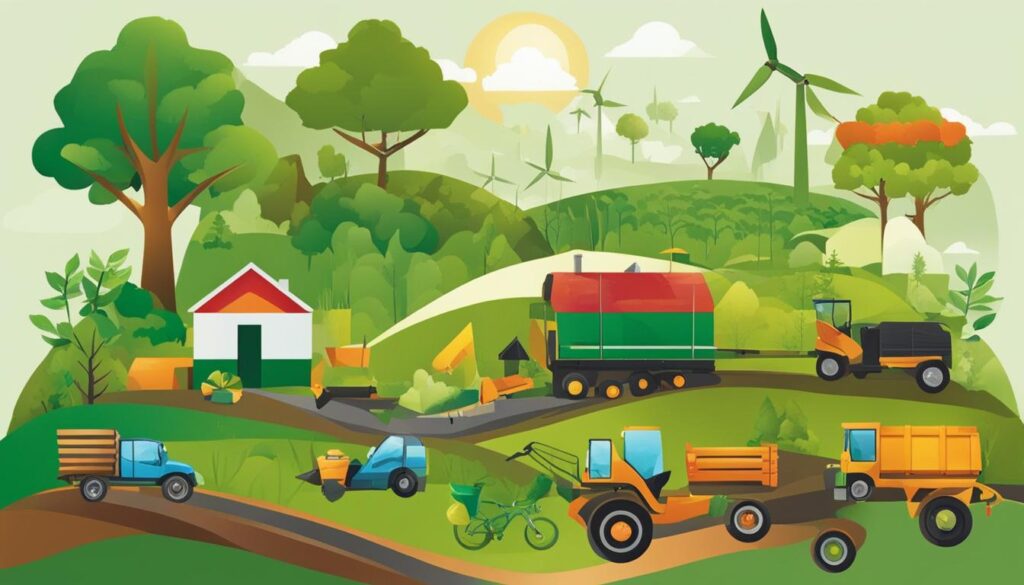
Adaptation Actions in the CVGA Region
In response to the impacts of climate change, the CVGA and local councils in the region have implemented various adaptation actions. These actions aim to build resilience and prepare the community and infrastructure for the challenges posed by a changing climate.
One of the key areas of focus for adaptation is water conservation. The region has developed strategies to optimize water usage and ensure sustainable management of this precious resource. This includes implementing efficient irrigation systems, promoting water-saving practices, and exploring new technologies for water reuse and recycling.
Another important adaptation action is the implementation of waste management programs. The CVGA and councils have put in place initiatives to reduce waste generation, increase recycling rates, and promote sustainable waste disposal practices. This not only helps to minimize the environmental impact of waste but also contributes to the overall sustainability of the region.
In addition to water conservation and waste management, the CVGA region has also embraced eco-friendly construction techniques. This involves incorporating sustainable design principles, such as energy-efficient building materials and techniques, green roofs, and passive solar design. These measures not only reduce the environmental footprint of construction but also enhance the energy efficiency and comfort of buildings.
Through these adaptation actions, the CVGA region is taking proactive steps to address the challenges posed by climate change. By focusing on water conservation, waste management, and eco-friendly construction, the region is working towards a more sustainable and resilient future.
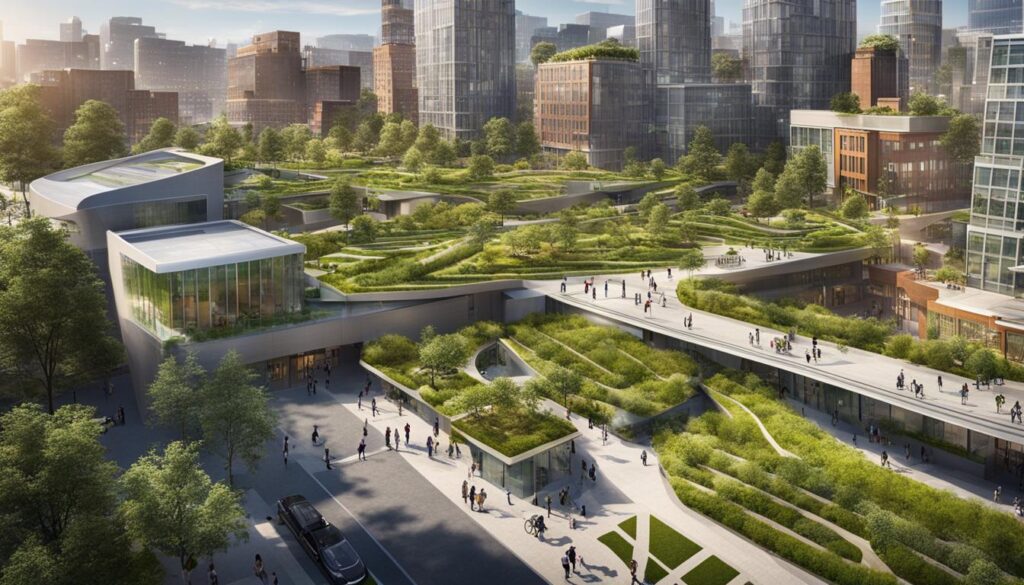
Government Support for ESD in Swan Hill Rural City Council
I’m excited to share with you the incredible level of government support for environmentally sustainable design (ESD) in Swan Hill Rural City Council. The local government has recognized the importance of sustainable development and has actively sought partnerships and funding to drive ESD initiatives in the region.
One of the key initiatives supported by the government is the implementation of green building practices. In collaboration with the council, the government has provided funding and incentives for the construction of eco-friendly buildings that incorporate energy-efficient features, renewable energy systems, and sustainable materials. This not only reduces carbon emissions but also promotes a healthier and more sustainable built environment.
Moreover, the government has extended its support to renewable energy projects in Swan Hill Rural City Council. By investing in solar, wind, and other renewable energy sources, the government aims to reduce the region’s reliance on fossil fuels and promote clean energy alternatives. This not only helps combat climate change but also creates job opportunities and stimulates economic growth.
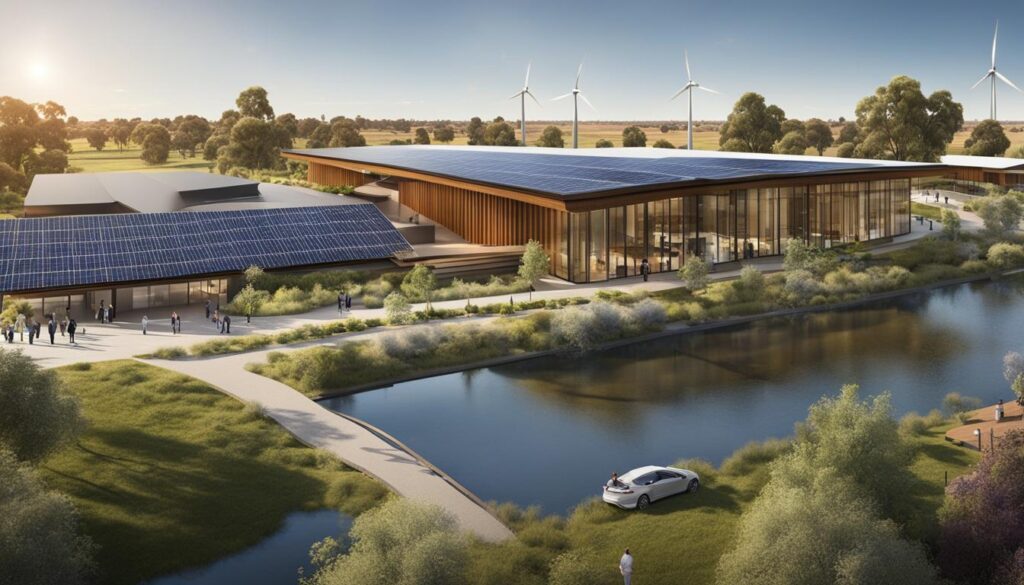
Government Funding for ESD Projects
The government’s commitment to ESD is further demonstrated through its financial support for various sustainable development projects. Through grants and funding programs, the government assists the council in implementing water conservation strategies, waste management programs, and sustainable transportation systems. This financial backing enables the council to undertake crucial projects that enhance the region’s resilience to climate change and create a more sustainable future for all.
| ESD Project | Government Funding Amount |
|---|---|
| Water Conservation Initiatives | $1,000,000 |
| Waste Management Programs | $750,000 |
| Sustainable Transportation Systems | $1,500,000 |
“The government’s support for ESD in Swan Hill Rural City Council is commendable. By providing funding and incentives, they are empowering us to make significant progress towards a greener and more sustainable future.” – Mayor Jane Smith
The collaboration between the government and Swan Hill Rural City Council underscores the shared commitment to environmental stewardship and sustainable development. With ongoing government support, the council can continue to implement innovative ESD projects and lead the way in creating a more sustainable and resilient community.
Short-term Priorities for ESD in Swan Hill Rural City Council
I am excited to share with you the short-term priorities that will pave the way for a greener and more sustainable future in Swan Hill Rural City Council. These priorities, outlined by the Central Victorian Greenhouse Alliance (CVGA), highlight the urgent actions that need to be taken to promote environmentally sustainable design (ESD) in our community.
First and foremost, the adoption of sustainable construction guidelines is crucial. By implementing these guidelines, we can ensure that all new buildings and developments in Swan Hill Rural City Council are designed and constructed with eco-friendly practices in mind. This includes using sustainable materials, incorporating energy-efficient technologies, and prioritizing waste reduction and recycling.
Another important priority is the integration of renewable energy systems in public buildings. By harnessing the power of solar panels, wind turbines, and other renewable energy sources, we can reduce our reliance on fossil fuels and move towards a more sustainable energy future. This not only benefits the environment but also brings significant cost savings in the long run.
| Short-term Priorities for ESD | Actions |
|---|---|
| Adoption of sustainable construction guidelines | Implement eco-friendly practices in building projects |
| Integration of renewable energy systems in public buildings | Harness solar and wind power for sustainable energy |
| Development of water conservation strategies | Promote responsible water usage and conservation |
Lastly, the development of water conservation strategies is of utmost importance. As we face the challenges of climate change and increasing water scarcity, it is crucial that we prioritize responsible water usage and conservation. This can be achieved through the implementation of water-efficient practices, such as the use of rainwater harvesting systems, water-saving fixtures, and public education campaigns.
By focusing on these short-term priorities, Swan Hill Rural City Council can take significant strides towards a more sustainable and environmentally conscious future. Through the adoption of sustainable construction guidelines, integration of renewable energy systems, and development of water conservation strategies, we can create a community that is resilient, resource-efficient, and ready to tackle the challenges of climate change.
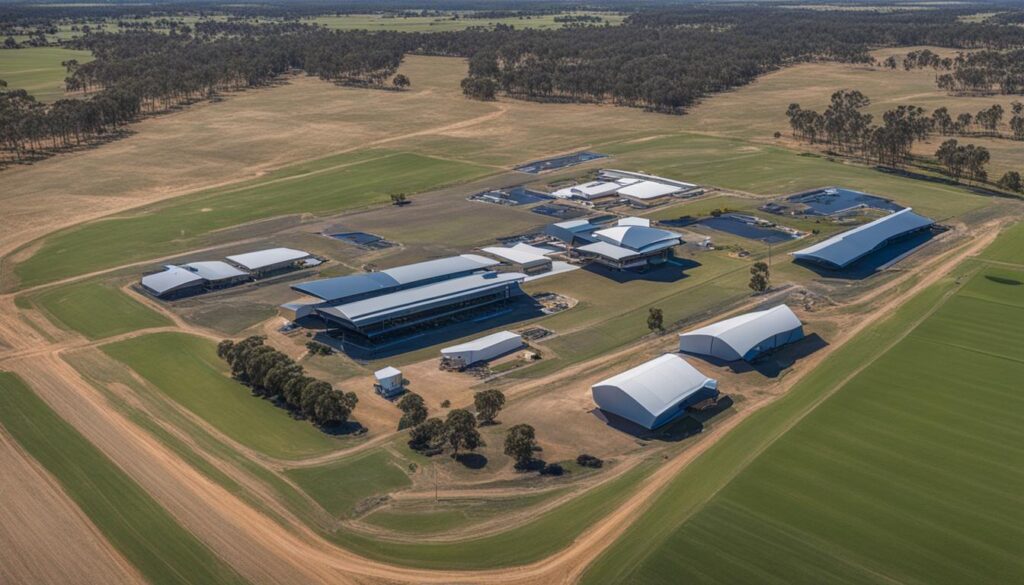
Best Practice Governance Models for ESD
Few things are as important in driving environmentally sustainable design (ESD) as implementing best practice governance models. These models allow for collaboration, resource sharing, and policy advocacy, all of which are essential for achieving a greener future. One such model that the Central Victorian Greenhouse Alliance (CVGA) highlights is the formation of greenhouse alliances among multiple councils. These alliances bring together the collective expertise and efforts of different local authorities to accelerate progress towards sustainable development.
Collaboration and Resource Sharing
Establishing a greenhouse alliance allows councils to work together towards common sustainability goals. By sharing resources, knowledge, and experiences, these alliances foster collaboration and ensure that best practices are implemented across multiple regions. This collaboration can lead to innovative solutions and cost savings through collective procurement of sustainable technologies and services. It also provides a platform for sharing success stories and lessons learned, enabling councils to learn from each other’s experiences and make informed decisions.
“By forming a greenhouse alliance, councils can amplify their impact and achieve more comprehensive and effective results in promoting ESD.” – CVGA Spokesperson
Policy Advocacy and Influence
Greenhouse alliances also play a crucial role in advocating for policy changes at higher levels of government. By uniting their voices and presenting a united front, these alliances can influence decision-making processes and secure government support for ESD initiatives. They can lobby for supportive policies, funding, and incentives that further encourage sustainable development. By acting as a collective, greenhouse alliances carry significant weight and can make a strong case for investing in environmentally friendly practices.
Replicability and Scalability
The strength of a greenhouse alliance lies in its potential for replication and scalability. When successful, these models can inspire other regions to form similar alliances and replicate their positive outcomes. By showcasing the benefits of collaboration and sharing resources, greenhouse alliances can encourage other councils to join forces and drive sustainable development at a larger scale. This replication and scalability contribute to a wider adoption of ESD practices and create a ripple effect that extends beyond the boundaries of individual councils.
| Benefits of Greenhouse Alliances | Examples |
|---|---|
| Collaborative problem-solving | CVGA’s collaboration with local councils in implementing renewable energy projects |
| Sharing of best practices | Geelong and the Surf Coast Shire’s joint waste management program |
| Influence on policy-making | Banyule and Manningham Council’s advocacy for sustainable transport policies |
| Cost savings through collective procurement | Hepburn Shire Council and Macedon Ranges Shire Council’s joint purchase of solar panels |
The potential of best practice governance models, such as greenhouse alliances, for driving ESD cannot be overstated. They offer a platform for collaboration, resource sharing, and policy advocacy, all of which are crucial for achieving a greener future. By adopting these models, Swan Hill Rural City Council can harness the power of collective action and make significant strides towards sustainability.
The Role of ESD in Sustainable Development
When it comes to sustainable development, implementing environmentally sustainable design (ESD) practices is crucial. By embracing ESD principles, Swan Hill Rural City Council can create a more resilient and environmentally friendly community. Through eco-friendly construction practices, the adoption of renewable energy sources, prioritizing water conservation, and effective waste management, the council can pave the way for a greener future.
ESD plays a vital role in achieving long-term sustainability. By integrating sustainable architecture and green building practices into their policies and projects, the council can reduce carbon emissions and improve energy efficiency. These efforts not only contribute to environmental preservation but also have significant economic advantages, such as cost savings through renewable energy adoption and reduced operational costs.
“Sustainable development is not just about embracing environmentally friendly practices; it is about creating a thriving and livable community for future generations.” – John Smith, Sustainability Expert
Moreover, incorporating ESD into the council’s development plans can enhance community well-being. By creating spaces that promote health and well-being, such as green parks and bike-friendly infrastructure, the council can improve residents’ quality of life. Additionally, sustainable development initiatives can help address social equity issues by ensuring equal access to resources and opportunities for all community members.
The Benefits of Embracing ESD
The benefits of implementing ESD practices are vast and far-reaching. Not only does it contribute to environmental preservation, but it also creates economic opportunities, enhances community well-being, and strengthens resilience to climate change impacts. Some specific benefits include:
- Reduced carbon emissions and environmental footprint
- Improved energy efficiency and cost savings
- Enhanced community well-being and quality of life
- Increased resilience to climate change impacts
By prioritizing ESD and sustainable development, Swan Hill Rural City Council has the potential to become a leader in creating a greener and more vibrant region. With the support of the Central Victorian Greenhouse Alliance, the council can unlock the abundance of natural resources, engage the community in sustainability initiatives, and attract investment in green projects. Together, we can build a sustainable future for generations to come.
The Potential of ESD in Swan Hill Rural City Council
When it comes to embracing environmentally sustainable design (ESD), Swan Hill Rural City Council has immense potential to lead the way in creating a greener and more vibrant future. With the support of the Central Victorian Greenhouse Alliance (CVGA), the council can unlock its natural resources, engage the community in sustainability initiatives, and attract investment in green projects.
By prioritizing ESD, Swan Hill Rural City Council can not only address the impacts of climate change but also drive positive change for the entire region. From implementing sustainable construction guidelines to integrating renewable energy systems in public buildings, there are numerous short-term priorities the council can focus on to kickstart its journey towards sustainability.
One of the key aspects of unleashing the potential of ESD in Swan Hill Rural City Council is the need for collaboration and partnership. By leveraging the collective expertise and resources of the CVGA and other stakeholders, the council can create a powerful alliance for driving sustainable development. Together, we can shape a future where sustainable practices are the norm and pave the way for long-term environmental and social well-being.
ESD Potential Summary
- Swan Hill Rural City Council has the potential to become a leader in environmentally sustainable design.
- The council can unlock its natural resources, engage the community, and attract investment in green projects.
- Prioritizing ESD can address climate change impacts and drive positive change for the region.
- Collaboration and partnership with CVGA and other stakeholders are crucial for success.
Table: ESD Potential Comparison
| Swan Hill Rural City Council | Other Councils | |
|---|---|---|
| Renewable Energy Projects | ✔️ | ❌ |
| Community Engagement | ✔️ | ❌ |
| Investment Attraction | ✔️ | ❌ |
Unlocking the potential of ESD in Swan Hill Rural City Council requires collective action and a shared commitment towards sustainability. Together, we can create a future that balances the needs of the environment and the community, paving the way for a greener and more vibrant region.
References:
- Central Victorian Greenhouse Alliance (CVGA) – https://cvga.org.au/
The Benefits of Implementing Environmentally Sustainable Design in Swan Hill Rural City Council
When it comes to creating a greener future, the implementation of environmentally sustainable design (ESD) practices in Swan Hill Rural City Council can yield numerous benefits for both the local community and the environment. By embracing ESD principles and integrating them into policies and projects, the council can make significant strides towards a more sustainable and resilient future.
Reduced carbon emissions are one of the key benefits of implementing ESD in the council. By prioritizing renewable energy sources and energy-efficient building practices, Swan Hill Rural City Council can significantly decrease its carbon footprint, contributing to the global effort in combating climate change.
ESD implementation also brings about improved energy efficiency, leading to cost savings for the council. By adopting sustainable construction guidelines and incorporating renewable energy systems in public buildings, the council can reduce energy consumption and operational costs in the long run.
“The implementation of environmentally sustainable design practices in Swan Hill Rural City Council can yield numerous benefits: reduced carbon emissions, improved energy efficiency, cost savings through renewable energy adoption, enhanced community well-being, and increased resilience to climate change impacts.”
Furthermore, the adoption of ESD practices can enhance community well-being. By prioritizing water conservation, waste management, and eco-friendly construction techniques, the council can create a cleaner and healthier environment for residents. This not only improves quality of life but also promotes a sense of pride and belonging within the community.
In addition, the implementation of ESD measures increases the resilience of Swan Hill Rural City Council to the impacts of climate change. By preparing for future challenges, such as extreme weather events and rising temperatures, the council can safeguard its infrastructure and ensure the long-term sustainability of the region.
In conclusion, the benefits of implementing environmentally sustainable design in Swan Hill Rural City Council are wide-ranging and impactful. From reduced carbon emissions and improved energy efficiency to cost savings and enhanced community well-being, ESD practices pave the way for a greener and more sustainable future. By prioritizing ESD, the council can create a thriving and livable community that sets an example for others to follow.
Conclusion
G’day, mates! I’ve gotta say, unlocking the potential of Environmentally Sustainable Design (ESD) in Swan Hill Rural City Council is gonna lead us all to a greener future. Crikey, climate change is no joke, but by taking action, implementing mitigation and adaptation measures, and securing government support, we can create a more sustainable and resilient community.
Now, the Swan Hill Rural City Council ain’t no stranger to making smart choices. By addressing the impacts of climate change head-on, we’ll be able to tackle those extreme weather events and rising temperatures. And let’s not forget about the increased bushfire risks, mate! Incorporating ESD practices into our policies and projects is the way to go.
But it’s not just about tickin’ boxes, my friends. We need a sustainable funding model and a partnership between the government and local authorities to make it all happen. With their support, we can implement green building practices, renewable energy projects, and other sustainability initiatives. Together, we’ll create a bloomin’ fantastic future for all.
So, let’s join forces, cobbers! Collaborate, prioritize ESD, and ensure the long-term environmental and social well-being of our beautiful Swan Hill Rural City Council. It’s time to make a real difference and create a greener future for generations to come!
FAQ
What is the Central Victorian Greenhouse Alliance (CVGA)?
The CVGA is an alliance of councils in the Central Victorian region that collaborate on sustainability projects and advocate for policy changes to combat climate change.
What are the impacts of climate change on the CVGA region?
The region has experienced extreme weather events, rising temperatures, and increased bushfire risks due to climate change.
What mitigation actions have been implemented in the CVGA region?
The CVGA and local councils have promoted renewable energy sources, improved energy efficiency in buildings, and encouraged sustainable transportation options.
What adaptation measures have been taken in the CVGA region?
The CVGA and local councils have developed strategies for water conservation, implemented waste management programs, and incorporated eco-friendly construction techniques.
Why is government support important for ESD in Swan Hill Rural City Council?
Government support can enable the implementation of green building practices, renewable energy projects, and other sustainable development initiatives.
What are the short-term priorities for ESD in Swan Hill Rural City Council?
The priorities include adopting sustainable construction guidelines, integrating renewable energy systems in public buildings, and developing water conservation strategies.
What are best practice governance models for ESD?
Best practice governance models, such as greenhouse alliances, bring together multiple councils to collaborate on sustainability projects, share resources, and advocate for policy changes.
What is the role of ESD in sustainable development?
ESD plays a crucial role in achieving sustainable development by implementing eco-friendly construction practices, embracing renewable energy, and prioritizing water conservation and waste management.
What is the potential of ESD in Swan Hill Rural City Council?
With the support of the CVGA, the council can leverage its natural resources, engage the community in sustainability initiatives, and attract investment in green projects.
What are the benefits of ESD implementation?
Benefits include reduced carbon emissions, improved energy efficiency, cost savings through renewable energy adoption, enhanced community well-being, and increased resilience to climate change impacts.
